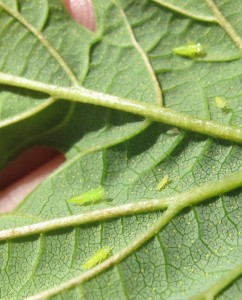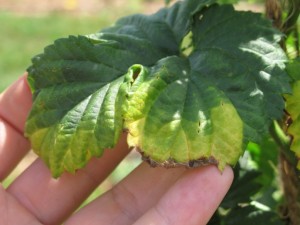
As we all know, it has been an impressively rainy season so far here in the Northeast. While the rain has fueled pests like downy mildew and aphids in our hopyard, potato leafhoppers (PLH) have thus far posed less of a threat to the production of our hops. However, even with lower numbers, these pests can still do damage to regional hopyards. Knowing what to look for and having a management plan to combat these pests will help in preventing plant damage and decreases in yields.
Potato leafhoppers overwinter in southern states and are carried north with the spring wind currents. Depending on winter temperatures, these insects can arrive in the Northeast between late spring and mid-June. The warmer the winter, the further these insects will travel north. Leaf hopper populations typically peak around July 1 depending on when they arrive and then start dying down around the beginning of August. While damage from these pests will soon start coming to an end for this growing season, PLH management should continue over the next months.
When scouting for leafhoppers, hop leaves should be turned over and observed. PLH are long and skinny and move from side to side. Adults are larger than their nymph counterparts and are winged. When searching for adult potato leafhoppers, leaves of the hops plants can be shaken and the adults will often fly away.
PLH may be confused with aphids which are much less active, are round in shape and are often found between the midrib and veins of the leaves.
If you identify potato leafhopper in your yard, management options include:
- Pyrethroid Insecticide application (make sure it is labeled for hops);
- Bio-control like lady bugs and other predatory insects; and
- Installation of trap crops like red clover or alfalfa.

Not properly managing the leafhopper can cause significant damage in hop yards and dramatically reduce yields. The leafhoppers have piercing-sucking mouthparts that damage the leaf tissue and stem phloem of the plants. This feeding technique causes necrosis of the leaf known as hopperburn, where the tip and outer edges of the leaf to yellow and then brown. Hopperburn reduces the photosynthetic capacity of the plant and thus reduces the energy available to produce cones. That said, it is imperative that leafhoppers are managed in some way or another.
With the rainy summer we’ve had, there’s a good possibility next season will be drier. With a drier, warmer season comes more potato leafhoppers. Preparing for the leafhoppers for next season may be a key to success in producing higher hops yields in 2018.